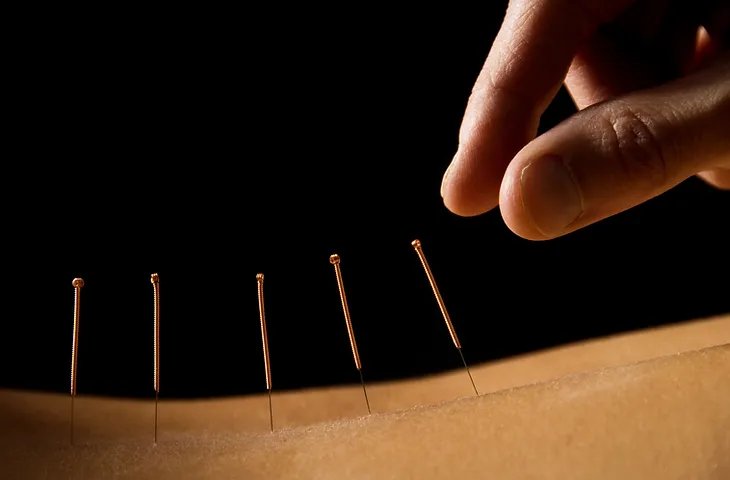Trigger Point Dry needling

What is Dry Needling?
Dry Needling is the insertion of an acupuncture needle, a very thin monofilament non-medicated stainless steel needle, into the soft tissues of the body—typically into a myofascial trigger point. Thus, it is often referred to as Trigger Point Dry Needling (TDN). A trigger point is a taut, hyperirritable band found within a muscle which can cause a characteristic pattern of pain locally or at a distance from the trigger point. They are the result of an imbalance between the nervous system and the muscular system that is manifesting within the muscle at the neuromuscular junction, where a nerve meets a muscle. Non-irritable taut bands are common throughout the body, however, hyperirritable bands are found in areas of pain and dysfunction. Weakness, abnormal recruitment of muscles, a loss of range of motion, headaches, disturbed sleep, and even tinnitus are also characteristic of trigger points.
Stimulating a trigger point can cause a muscle twitch, sensory response, and autonomic response, sometimes manifesting as slight sweating or goosebumps. When the needle punctures the skin, it’s normal to feel a small pin-prick, and a variety of sensations such as aching, and neural sensations radiating from the area—sometimes even a reproduction of the same pain you have been experiencing. The sensations are dependent on the presence of trigger points and are variable from point to point. In areas without trigger points, the same acupuncture needles would likely cause sensations that are barely noticeable.
The stainless steel of an acupuncture needle carries a small electrical charge, enough to stimulate a trigger point to cause a strong muscle twitch. This results in the opening of acetylcholine channels and the clearing of neurotransmitters in excess at the neuromuscular junction. The result is a reflexive relaxation of the muscle due to improved neuromuscular balance. The reduction of a trigger point results in an improvement of the patient’s complaint. Whether it is pain, lack of mobility, or muscle performance, the results are many times immediate and are usually significant. In addition, the microtrauma of the tiny puncture created by the needle causes an anti-inflammatory immune reaction and improved blood flow, which leads to self-healing and internal balance.
At Latitude Physiotherapy, we use high-quality Korean acupuncture needles from .30 to .16 mm in thickness, much thinner than the average needle used for medical injections. Dr. Gumbs has extensive experience with TDN, and in 2016 he earned the International Certification in Dry Needling. He does his best to individualize each treatment based on the patient’s comfort level and feedback. Most of our patients remark that it isn’t so painful like they thought it would be, more so just a strange sensation unlike what they’ve experienced before.
TDN is a valuable treatment for musculoskeletal pain, but like any treatment, complications are possible. While complications are extremely rare, we recommended you read about the possible risks prior to consenting to treatment.
Risks of Dry Needling
There are very few risks from treatment with TDN. Although unlikely, a pneumothorax, the accidental puncture of a lung, is the most serious risk. However, if this were to occur it may only require a chest X-ray and can normally resolve on its own without any further treatment. Mild pain and shortness of breath may last for several days to weeks. A severe puncture could require hospitalization and re-inflation of the lung. This is an extremely rare complication, and a properly trained practitioner is able to safely avoid all major vessels, and the lung field. If a pneumothorax is suspected you should seek medical attention from your physician, or if necessary, go to the emergency room. Another very uncommon risk is an infection, however, you can rest assured we take precautions to ensure your safety using gloves, alcohol to clean the skin, and a new clean field with every patient. If you have any conditions that can be transferred by blood, require blood anticoagulants, or other conditions that may have an adverse effect to needle punctures, please notify your TDN provider. Redness and bruising is a common occurrence and should not be a concern unless you are taking blood thinners.
It is common to feel very relaxed, energized, or tired after the treatment. Other reactions that are not worrisome include pain, bruising, soreness, ache/discomfort at areas other than the needlepoint, and mild bleeding (usually no more than a droplet). Possible, but less common side effects could include feeling faint, dizzy, or nauseous, and are normal reactions that may be present due to changes in blood pressure (high or low), first experience with TDN, and/or psychological factors. If you have any further questions, please contact Latitude Physiotherapy.

